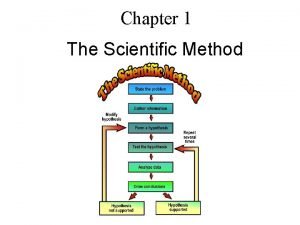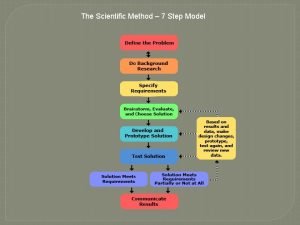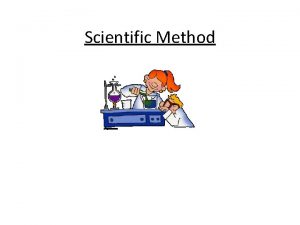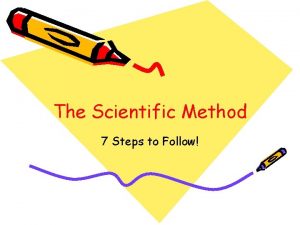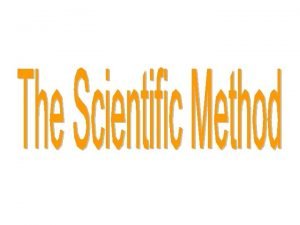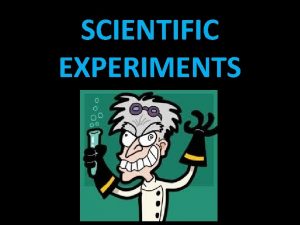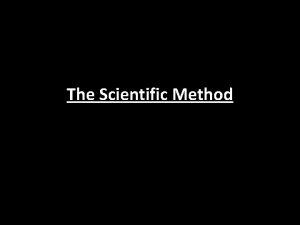7 STEPS OF THE SCIENTIFIC METHOD Step 1








- Slides: 8

7 STEPS OF THE SCIENTIFIC METHOD

Step 1 - Observation • Using your 5 senses to learn about the natural world. • Ex: hearing crickets chirping at night • Ex: seeing bats catch insects over a brightly lit street lamp.

Step 2 – Ask Questions • Asking questions: 1) helps you define a problem 2) allows you to search for logical explanations 3) helps you find ways to solve problems Ex: Why do insects congregate (gather) around bright lights? Ex: How does the bat locate insects in the dark?

Step 3 – Perform Research • Collecting background information about the subject • Helps you find out what questions still need to be answered. • Reliable research sources: – – Internet sites that are updated daily News outlet sites Government or university websites Peer reviewed professional journals **BEWARE BIAS – the tendency to present inaccurate or unreasonable judgment for personal gain.

Step 4 – Form a Hypothesis • An educated guess based on observed patterns over time. – Inductive reasoning: use observations of specific events to make a hypothesis about general trends. • Ex: Jill notices each time she throws a ball up, it comes down. She inductively reasons that next time she throws the ball up, it will come down. – Deductive reasoning: use a general truth to hypothesize particular events. • Ex: Cory uses deductive reasoning to say, “That’s Newton’s Theory of Gravity – what goes up, must come down. So next time you throw the ball up, it will certainly come down. ”

Step 5 – Test the Hypothesis • A scientific experiment gives measurable results which prove or disprove the hypothesis. • ONE variable is tested at a time. – Independent variable – the factor that is changed by the researcher on purpose – Dependent variable – the factor that changes because of the independent variable; the factor that is measured or counted. – Control variables – all the other factors that are kept constant (not changed) during the experiment

Step 6 – Collecting & Presenting Data • Data is gathered from observations & measurements taken during an experiment. – Qualitative data: observations made with your senses; cannot be represented with numbers. • Ex: shades of colors, tastes, smells, etc. – Quantitative data: measurements that are expressed as numbers • Ex: length, weight, mass, volume, time, temperature, etc.

Step 7 – Drawing Conclusions • Conclusion – a judgment based on observation & experimentation. • A logical statement made from the results of the experiment.
 Step 1 step 2 step 3 step 4
Step 1 step 2 step 3 step 4 Information gathered during an experiment
Information gathered during an experiment Scientific method manipulated and responding variables
Scientific method manipulated and responding variables Observations in scientific method
Observations in scientific method What is the step in scientific method
What is the step in scientific method What is the step in scientific method
What is the step in scientific method What is the step in scientific method
What is the step in scientific method 7 steps of the scientific method
7 steps of the scientific method The first step in the scientific method involves
The first step in the scientific method involves


